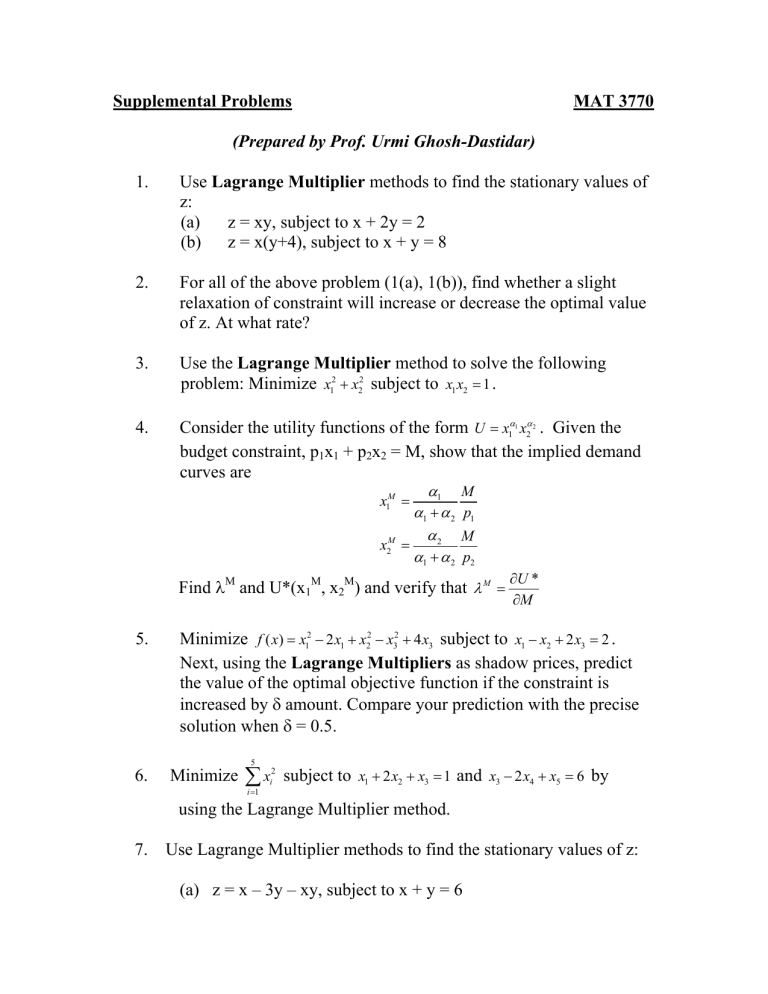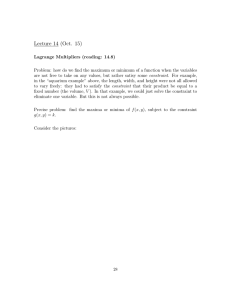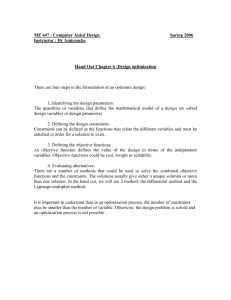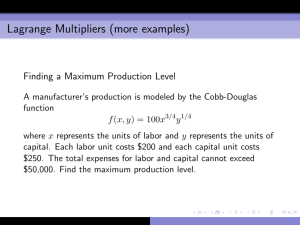
Supplemental Problems
MAT 3770
(Prepared by Prof. Urmi Ghosh-Dastidar)
1.
Use Lagrange Multiplier methods to find the stationary values of
z:
(a)
z = xy, subject to x + 2y = 2
(b)
z = x(y+4), subject to x + y = 8
2.
For all of the above problem (1(a), 1(b)), find whether a slight
relaxation of constraint will increase or decrease the optimal value
of z. At what rate?
3.
Use the Lagrange Multiplier method to solve the following
problem: Minimize x12 + x22 subject to x1 x2 = 1 .
4.
Consider the utility functions of the form U = x1α x2α . Given the
budget constraint, p1x1 + p2x2 = M, show that the implied demand
curves are
1
α1
α1 + α 2
α2
x2M =
α1 + α 2
x1M =
M
p1
M
p2
Find λM and U*(x1M, x2M) and verify that λ M =
5.
∂U *
∂M
Minimize f ( x) = x12 − 2 x1 + x22 − x32 + 4x3 subject to x1 − x2 + 2x3 = 2 .
Next, using the Lagrange Multipliers as shadow prices, predict
the value of the optimal objective function if the constraint is
increased by δ amount. Compare your prediction with the precise
solution when δ = 0.5.
5
6.
2
Minimize
∑x
2
i
subject to x1 + 2 x2 + x3 = 1 and x3 − 2 x4 + x5 = 6 by
i=1
using the Lagrange Multiplier method.
7.
Use Lagrange Multiplier methods to find the stationary values of z:
(a) z = x – 3y – xy, subject to x + y = 6
(b) z = 7 – y + x2, subject to x + y = 0
8.
For all of the above problem (7(a), 7(b)), find whether a slight
relaxation of constraint will increase or decrease the optimal value of z.
At what rate?
9.
Consider the following system of linear constraints:
2 x1 + x2 ≤≤ 100
x1 + x2 ≤ 80
x1 ≤ 40
x1 , x2 ≥ 0
Determine the extreme points of the feasible region.
10. Consider the following system of inequalities:
x1 + x2 ≤ 5
x1 + 2 x2 ≤ 6
x1 , x2 ≥ 0
Find the extreme points of the region defined by these inequalities.
Does this set have any directions of unboundedness? Either prove that
none exists or give an example of direction of unboundedness.
11. Minimize z given the following constraints:
z = − x1 − 2 x2
subject to
−2 x1 + x2 ≤ 2
− x1 + x2 ≤ 3
x1 , x2 ≥ 0
12. Maximize z = x1 + 2x2 subject to x1 – 2x2 ≥ 12, x1 + x2 ≥ 5, -x1 +
3x2 ≤ 3, 6x1 – x2 ≥ 12, x1, x2 ≥ 0.
1
2
1
2
13. Minimize f(x) = x12 + x22 subject to x1 + 2 x2 ≥ 2, x1 − x2 ≥ −1, − x1 ≥ −3 ;
Show the feasible region graphically and solve this problem graphically.
14. Maximize z = 6x1 – 3x2 subject to 2x1 + 5x2 ≥ 10, 3x1 + 2x2 ≤ 40, x1 ≤ 15,
x2 ≤ 15. Draw the feasible region and solve the problem graphically.
15. Find all local minimizers and maximizers of f:
1
1
1
f ( x1 , x2 ) = x13 + x12 + 2 x1 x2 + x22 − x2 + 9 .
3
2
2
16. Consider the function f: f ( x1 , x2 ) = 8 x12 + 3 x1 x2 + 7 x22 − 25 x1 + 31x2 − 29 .
Find all stationary points of this function and determine whether
they are local minimizers or maximizers. Does this function have
a global minimizer or a maximizer?
17. An oil transfer company Problem:
Consider a situation in which we are hired as consultants for a small oil
transfer company. The management desires a policy of minimum cost due to
restricted tank storage policy. Minimize the costs associated with dispensing
and holding the oil to maintain sufficient oil to satisfy demand while
meeting the restricted tank storage space constraint by using Lagrange
Multiplier method.
Assumptions: Many factors determine the total cost of transferring oil. For
our model we include the following variables: holding costs of the oil in the
storage tank, costs of the oil in the storage tank, withdrawal rate of the oil
from the tank per unit time, the cost of the oil, and the size of the tank.
Model Formulation:
xi = the amount of oil type i available, i = 1, 2
ai = the cost of the oil of type i
bi = withdrawal rate per unit time of oil type i
hi = holding(storage) costs per unit time for oil type i
ti = space in cubic feet to store one unit of oil type i
T = total amount of storage space available
Historical records have been studied and a formula has been derived that
describes the system costs in terms of our variables. Our objective is to
minimize the sum of the cost variables given a specified maximum storage
capacity.
Minimize f(x1, x2) = (
a1b1 h1 x1
ab hx
+
)+( 2 2 + 2 2)
2
x2
2
x1
Such that g(x1, x2) = t1x1 + t2x2 = T
Oil type i
1
2
ai($)
9
4
bi($)
3
5
ti(ft3)
2
4
hi($)
0.50
0.20
T = 24 ft3
18. Carpenter’s Problem:
A carpenter makes tables and bookcases. He is trying to determine how
many each type of furniture he should make each week. He wishes to
determine a weekly production schedule for tables and bookcases that
maximizes his profits. It costs $5 and $7 to produce tables and bookcases
respectively. The carpenter realizes that a net unit profit of $25/table and
$30/bookcase. He is trying to determine how many of each piece of furniture
he should make each week. He has up to 690 board ft. of lumber to devote
weekly to the project and up to 120 hour of labor. He estimates that it
requires 20 board ft. of lumber and 5 hours of labor to complete a table and
30 board ft. of lumber and 4 hours of labor to complete a bookcase. Solve
this problem using a) graphically and, b) simplex method.
19. Minimize F ( x) = x12 + 3x1 x2 subject to c1(x) = x1 + 5x2 –1 = 0. Use the
Lagrangian multiplier to predict what the optimum value would be if the
4
3
constraint were changed to x1 + 5x2 − = 0 . Solve the problem with this
modified constraint and hence determine the accuracy of the prediction.
2
3
Also, do similar calculations for the modified constraint x1 + 5x2 − = 0 .
20. Solve the linear program graphically:
Minimize z = x1 + 2x2
subject to 2x1 + x2 ≥ 12
x 1 + x2 ≥ 5
-x1 + 3x2 ≤ 3
6x1 – x2 ≥ 12
x1, x2 ≥ 0.
21. Use simplex method to solve the following problem:
Maximize z = 3x1 – 4x2 + 5x3 + x4
-3x1 – 2x2 + 6x3 – 9x4 ≥ 0
2x1 + 4x2 + 8x3 – 5x4 ≥ -3
-3x1 – x2 + 2x3 + 4x4 ≤ 15
xj ≥ 0 for all j = 1, 2, 3, 4
22. Barbie and Ken problems
A manufacturer sells Barbie and Ken dolls. The manufacturing prices for
each Barbie and Ken are $6 and $6.50 respectively. The company is
trying to determine how many of each type the company should make to
maximize its profit. The company has 100,000 oz. of plastics, 35,000
oz. of cardboard, and 30,000 oz. of nylon to use. The company estimates
that it requires 12 oz. of plastics and 4 oz. of cardboard to make a Barbie
doll and 14 oz.of plastics and 4 oz. of cardboard to complete Ken.
Moreover, each Barbie doll requires 5 oz. of nylon. Model this problem
as a linear programming problem. Solve by using simplex method.
23. Minimize the cost function C, where P is the pressure and R is the
recycle ration. Determine the optimal values of the pressure and recycle
ration and minimum cost within this constraint by direct substitution
and also, by using Lagrange Multiplier method.
Minimize C = 1000P +
4 × 109
+ 2.5×105 R subject to the constraints PR =
PR
9000.
24. Assignment Problem
Suppose that a company is planning to assign 3 people to 3 jobs. The
jobs are accountant, budget director, and personal manager. The first
two people have degrees in business, but the second has ten years of
corporate experience, while the first is just out of school. The first and
second both have some management experience, but in different
department. The third person’s degree was in anthropology. Based on
this information, the personnel depertment has determined numerical
values {ci,j} corresponding to each person’s appropriateness for a
particular job. Model it as an interger programming problem.
25. Maximize z = 5x1 + 8x2 subject to x1 + x2 ≤ 6, 5x1 + 9x2 ≤ 45, x1, x2 ≥
0 and both are integers. Solve this as an integer programming problem.
26. Minimize f(x, y) = x2 + 3y2 – 4x – 6y. Find out the minimum value of
f(x, y). Use a Matlab code to create a surface plot of f(x, y) for –10 ≤ x ≤
10, -10 ≤ y ≤ 10. Does the graph support your conclusion that you have
found in the first part?






